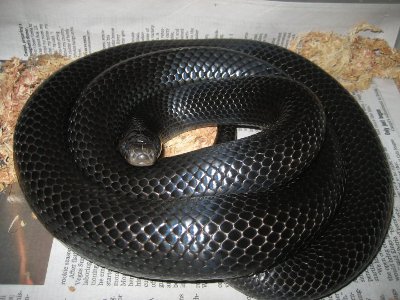Black Milk Snake
Category: Snakes

Facts about Black Milk Snakes. "Scientific name for Black Milk Snake is Lampropeltis triangulum gaigeae". Black Milk Snake is a Lampropeltis type of nontoxic snake that comes from the Colubridae family. The Black Milk Snakes are native to Middle-America, North-America and South-America. It is the biggest recognized milk snake in its family and they are largely found in the mountains of Panama and Costa Rica. The Black Milk Snakes have a Ne-arctic distribution and they are also found all through out the eastern parts of the United States, in the southern parts of Canada, and south into Central America and Mexico.
Features of Black Milk Snake
The Black Milk Snake has a brown or gray color body, and an adult snake is capable a attaining a body length, ranging from 14 to 69 inches (35 cm to 175 cm), and they are the longest snakes found in Central America and Mexico. Black Milk Snakes that are found in the United States usually have a body length between (23 and 51 inches (60 cm and 130 cm). The Black Milk Snake are extremely colorful snakes and their body color differs all through their range. The Black Milk Snakes have a mottled or striped look, with darker marks separated by lighter lines. The color of those darker marks can be extremely light to extremely dark, varying from brown to rust colored to dark tan. The color of the lighter regions can be yellow, orange, or white. The dark regions are outlined in black color. A Black Milk Snake will have 19 to 23 chains of smooth scales and one anal plate.
The Black Milk Snake has a light V or Y shaped patch on its neck, with a light-colored collar, black edged bands, divided by light rings. Both male and female Black Milk Snakes have the same body color. There are 25 dissimilar subspecies recognized all through the geographical range of the snake, all with minor color variations. During the daytime, these cautious snakes usually hide in stumps and logs, and beneath surface cover, but they may also be found in the open areas. It hibernates in a deep rock crevice or underground. Female Black Milk Snakes will lay eggs in sawdust piles, soil or under surface cover.
The Black Milk Snake can flourish in a range of homes. Their homes differ greatly among dissimilar geographic regions, such as semi desert to damp, lowland gorges to mountains, shrub lands and grasslands to forests and forest borders. The Black Milk Snake also live in open woodlands, prairies and plains, close to rivers and streams, on rock-strewn hillsides, and in housing regions and farmlands.
Diet of Black Milk Snake
The Black Milk Snake is carnivorous and it feeds on rodents, but they will also feed on bird eggs, Avesa (class of vertebrates comprising the birds), snake eggs, Squamata, including poisonous varieties, such as Viperidae and coral snakes. Juvenile Black Milk Snakes mainly feed on other juvenile snakes. When prey is confined, it is squeezed pending it suffocates and then, it is swallowed whole.
Behavior of Black Milk Snake
Though much is not known regarding the communication of the Black Milk Snake, it is estimated that they make use of hearing, sight, touch, and odor to make out their environment. The Black Milk Snakes make use of chemical cues to sense sex during their mating in the spring season. They are mostly nocturnal, but active during the daytime or nighttime, particularly in hot climate, and they are inactive in cold months.
The average lifespan of the Black Milk Snake ranges from 21 years to 22 years.

 Back To Category Snakes
Back To Category Snakes